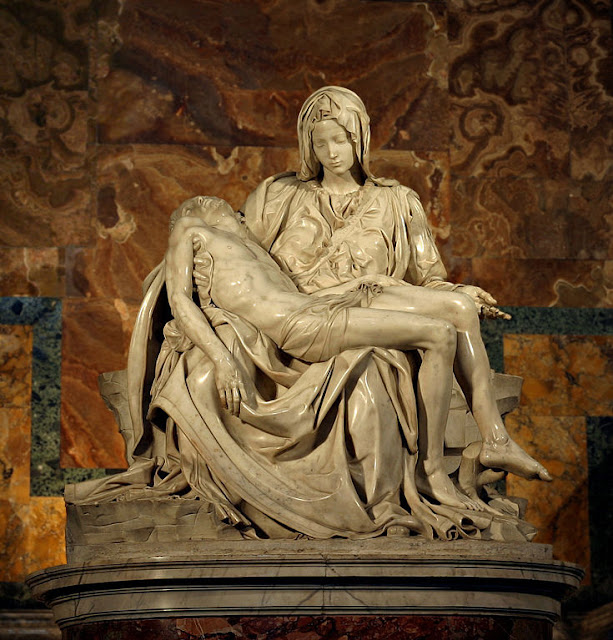The Kyrie in Divine Worship
A common and beautiful practice sustained in many, if not most, Ordinariate communities is the recitation of the ninefold Kyrie, in a manner such as the one that follows:
- Kyrie eleison: the cantor or choir intones the Kyrie, and, depending on the particular composition, the congregation typically joins in at the eleison.
- Kyrie eleison: the congregation sings along.
- Kyrie eleison: the choir (or cantor) sings alone.
- Christe eleison: the congregation sings along.
- Christe eleison: the choir (or cantor) sings alone.
- Christe eleison: the congregation sings along.
- Kyrie eleison: the choir (or cantor) sings alone.
- Kyrie eleison: the congregation sings along.
- Kyrie eleison: the choir (or cantor) sings the Kyrie and the congregation joins in at the eleison.
: : :
The 1549 Book of Common Prayer
Then shall he saie a Psalme appointed for the introite: whiche Psalme ended the Priest shall saye, or els the Clerkes shal syng,
iii. Lorde have mercie upon us.*
iii. Christ have mercie upon us.
iii. Lorde have mercie upon us.
* - the "iii" indicates that each line is said or sung three times.
: : :
John Merbecke: The Book of Common Prayer Noted (i.e., with musical notation).
Historical footnote: at the behest of Archbishop Cranmer, John Merbecke wrote a setting of the Kyrie in 1550, but due to turbulent shifts between differing factions and priorities in subsequent years, Merbecke's book "had no successor, and was essentially forgotten until the Oxford Movement rediscovered it in the mid-1800's."
: : :
Divine Worship: the Missal. The Rubrical Directory p. 124: n. 17.
The Kyrie is a prayer by which the faithful acclaim the Lord and implore his mercy. Each acclamation is usually pronounced twice, though it is not to be excluded that it be repeated several times, by reason of the character of the various languages, as well as of the artistry of the music or of other circumstances.
: : :
Adam Bartlett at adoremus.org:
In his classic work, The Mass of the Roman Rite, Joseph Jungmann describes the development of the Kyrie eleison, which in its earliest form was said or sung as a response to various petitions by all the faithful, much like our practice of the Prayer of the Faithful today. This is the practice described by the fourth century pilgrim Aetheria (or Egeria) in her written memoirs of a journey to Jerusalem. By the time of Gregory the Great (590-604), the response Christe eleison was added to the Kyrie, and the preceding petitions gradually began to disappear “in order to linger longer on these two invocations,” as Gregory states. The Kyrie and Christe, Jungmann says, were often repeated many times over during Gregory’s time, up to as many as forty times in the Byzantine East. As the Kyrie took shape in the Roman liturgy in the eighth century and beyond, however, its normal ninefold form (Kyrie eleison 3x, Christe eleison 3x, Kyrie eleison 3x) was established, modeling itself after the Trinitarian pattern. As Jungmann describes, “custom had thus consecrated the number three.” Dom Prosper Guéranger describes the trinitarian significance of the ninefold Kyrie, saying: “The first three invocations are addressed to the Father, who is Lord: Kyrie, Eleison; (Lord, have mercy). The following three are addressed to Christ, the Son incarnate: Christe, eleison. The last three are addressed to the Holy Ghost, who is Lord, together with the Father and the Son; and therefore, we say to him also: Kyrie, eleison.”
: : :
Masses written for the Anglican liturgy [WP]
Sometimes the Kyrie movement takes the form of sung responses to the Ten Commandments, 1 to 9 being followed by the words 'Lord have mercy upon us and incline our hearts to keep this law', and the tenth by 'Lord have mercy upon us and write all these thy laws in our hearts, we beseech thee'.
The 1552 Prayer Book included the above practice.
Divine Worship: the Missal, Appendix Three, p. 1046.
The Decalogue can be rehearsed, from time to time, in place of the Summary of the Law and the Kyrie. Turning to the People, the Priest or Deacon shall rehearse distinctly the Ten Commandments, and the People, kneeling or standing (according to custom) shall answer, asking God's mercy.


.jpg)





Comments
Post a Comment
Your comments will be appreciated and posted if 1) they are on topic and 2) preserve decorum.
Stand by your word.